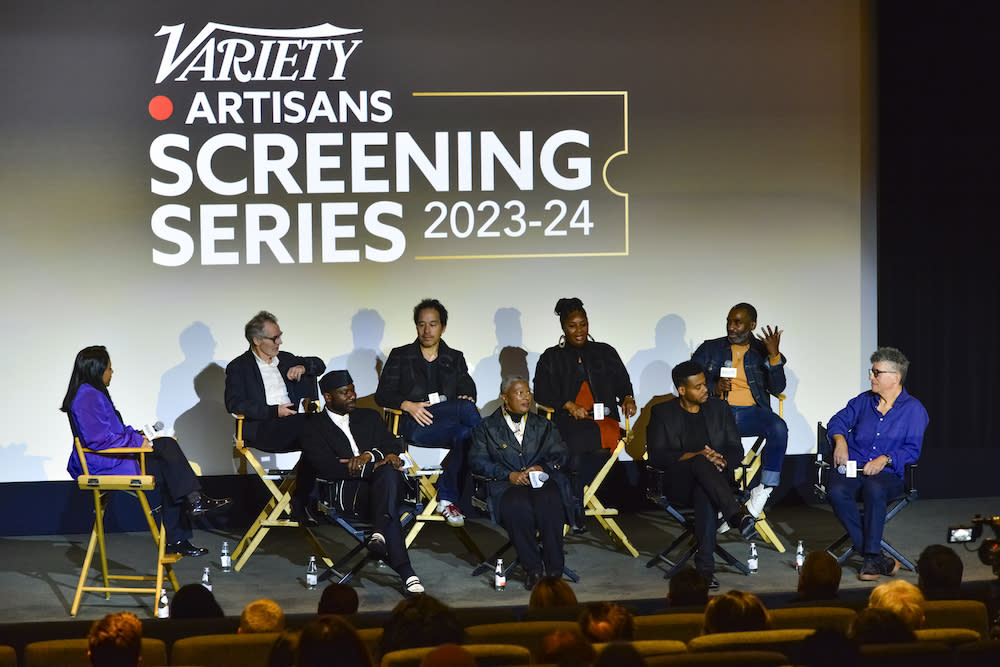‘The Color Purple’ Artisans Explain How a Giant, 22-Foot Gramophone Helped Transport Audiences Into Celie’s Imagination

- Oops!Something went wrong.Please try again later.
- Oops!Something went wrong.Please try again later.
“The Color Purple” director Blitz Bazawule hesitated to take on the latest incarnation of Alice Walker’s sacred text. However, when he revisited the book, the first line (“Dear God, I’m 14 years old”) struck him as a way to navigate a familiar story and “keep expanding Celie’s imagination.”
In the new musical movie adaptation, as Celie (Fantasia Barrino) is bathing Shug (Taraji P. Henson), an old record plays on a gramophone in the background. But as the camera zooms in, the record player becomes a stage for Celie to express herself and her emotions. In a two-hour storyboard video film, the director had pre-visualized how Celie’s imagination would be integral to every aspect of bringing “The Color Purple” back to life.
More from Variety
Oprah Winfrey Presents Behind the Scenes Look at 'The Color Purple' in New OWN Special (EXCLUSIVE)
A Tale of Two 'Color Purple' Supporting Actress Contenders, and Who Can Get Nominated
Bazawule was speaking at Variety‘s Artisans Screening Series, where he was joined by editor Jon Poll, costume designer Francine Jamison-Tanchuck, production designer Paul D. Austerberry, cinematographer Dan Laustsen, makeup department head Carol Rasheed, hair department head Lawrence Davis and composer Kris Bowers. Senior artisans editor Jazz Tangcay moderated the conversation.
Austerberry was tasked with building the giant gramophone that transforms into a stage for Celie. He said, “It ended up being a 22-foot diameter record.” While it ended up being a simple set, there were still additional requirements. Per Austerberry, “Practical effects rigged a turntable they already had to suit our size. They built it a little bit bigger. We had to hide all that machinery underneath and then figure out how to create the big arm with the needle on it.”
The visuals Bazawule had prepared came in handy for Laustsen, who navigated the simplicity of the scene by finding the right color balance. Said Laustsen, “It’s always nice to have storyboards because then you have the director’s vision, but you have to work around the storyboards into a real movie. I think the storyboards that Blitz had done were fantastic — it’s a really good inspiration for everybody, including myself. … You see the storyboards like a kind of guideline, and work around that.”
Poll revealed that Bazawule didn’t save filming the scene until the end, but rather kicked off the shoot with that dancing sequence. On receiving the dailies, Poll said, “It was just extraordinary. Our only problem cutting that scene was there were so many great shots. How do we not make it too cutty, but use all the beautiful angles?”
For Rasheed, one challenge was covering up the actors’ hundreds of tattoos. Once she had overcome that obstacle, she focused on progressive aging. “He wanted our skin to look like we really aged, so it wasn’t overdone,” she explained.
Davis’ pride came from showing this new side of Celie. He told the audience, it was about showing a glamorous side to the character that had never been seen before. “To be able to give Celie this glamorous look was just one of the things I was looking forward to so much in this movie … to still be authentic to what was there before, but give it the new spin and welcome a kinky edge.” He added, “I see Celie as a designer. She owned her boutique. She designed pants. We never look at her as a designer, but that’s the way I looked at her.”
Jamison-Tanchuck got to tell Celie’s story through texture and color in different eras. When Shug enters her world, Celine gradually comes into her own. Said the costume designer, “When she gave Celie that very special dress, I think it did something. It opened really a window into her inner self and her soul to say, ‘I am beautiful.'”
Bowers set the tone for the film with his score. The film opens with Colman Domingo’s Mister riding in on horseback playing the banjo. Bazawule was looking for a piece of music that would connect to the young audience. Said Bowers, “As soon as the opening credits start and that banjo starts, that kids is like, ‘Oh, this has got a little vibe to it’ and bumps their head. I feel like that mentality and working on that little piece of music was something that became a thread that continued through our process.”
Watch the full video above.
Best of Variety
Sign up for Variety’s Newsletter. For the latest news, follow us on Facebook, Twitter, and Instagram.

